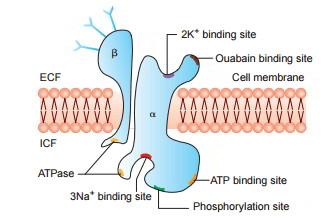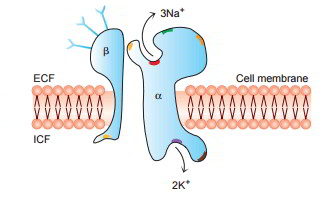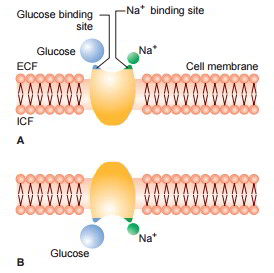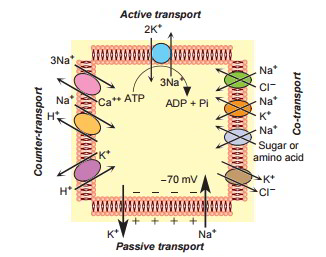Active transport describes the mechanism of transport of substances versus the chemical and/or electrical gradient. Active transport includes expense of energy which is freed by breakdown of high energy substances like adenosine triphosphate (ATP). Considering that the transport of substances happen versus the chemico-electrical gradient, this process is likewise called up-hill movement Substances carried actively across the cell membrane consist of:
Ionic substances such as Na+, K+, Ca2+, Cl − and I −, and Non-ionic substances like glucose, amino acids and urea.
Types of Active Transport
The active transport is of 2 types: Main active transport and Secondary active transport.
Primary Active Transport Processes
In main active transport process, the energy is obtained straight from the breakdown of ATP or some other high energy phosphate substance. A few of the essential pumps associated with the main active transport processes are: Sodium– potassium pump, Calcium pump and Potassium– hydrogen pump.
Sodium– Potassium Pump
Sodium– potassium (Na+– K+) pump exists in all the cells of the body. It is included with the active transport of sodium ions outwards through the cell membrane and potassium ions inwards concurrently. Hence, this pump is accountable for preserving the Na+ and K+ concentration distinctions across the cell membrane and for developing a negative electrical potential inside the cells.
Structure of Na+– K+ pump. The carrier protein associated with Na+– K+ pump is a complex including 2 different protein systems, a bigger α subunit (molecular weight roughly 100,000) and a smaller sized β subunit (molecular weight roughly 55,000). The α subunit is generally interested in Na+– K+transport It has actually got following binding sites:
- 3 intracellular sites, one each for binding sodium ions (3Na+) and ATP, and one phosphorylation site.
- 2 extracellular sites, one each for binding potassium ions (2K+) and ouabain.
Mechanism of operation of Na+– K+ pump.
The performance of Na+– K+ pump includes making use of enzyme ATPase. The enzyme ATPase is triggered when 3 sodium ions and one ATP molecule bind to their particular binding sites The triggered ATPase catalyzes the hydrolysis of ATP to ADP and frees a high-energy phosphate bond of energy (phosphorylation). The energy so liberated is thought to trigger a conformational modification in the carrier protein molecule extruding sodium into the extracellular fluid This is followed by binding of 2 potassium ions to the receptor site on extracellular surface of the carrier protein and dephosphorylation of a subunit which goes back to its previous conformation, launching potassium into the cytoplasm.
Functions of Na+– K+ pump.
The Na+– K+ pump subserves 2 primary functions:
- Managing the cell volume. It is the most essential function of the Na+– K+ pump, without which the majority of cells of the body will inflate till they break. When the Na+– K+ pump stops working the cells inflate and burst.
- Electrogenic activity. Na+– K+ pump functions as an electrogenic pump because it produces a net movement of positive charge from the cell (3Na+ out and 2K+ in); hence developing electrical potential across the cell membrane. This is standard requirement in nerves and muscles to transfer the signals.
Calcium Pump
The calcium pump kinds another essential active transport mechanism Like Na+– K+ pump, it likewise runs through a carrier protein which has ATPase activity. However, the distinction from Na+– K+ pump is that the carrier protein binds calcium ions instead of sodium and potassium ions. The calcium pump assists in preserving exceptionally low concentration of calcium in the intracellular fluid (10,000times less than the ECF).
Potassium– Hydrogen Pump
The main active transport system of hydrogen ion likewise runs through ATPase (K+– H+ ATPase) activity. These exist at following 2 locations in the human body: Parietal cells of gastric glands and Renal tubules.
Secondary Active Transport Processes
In secondary active transport processes, the energy is obtained secondarily from the energy which has actually been kept in the form of ionic concentration distinctions in between the 2 sides of a membrane, developed in the very first place by main active transports At lots of locations in the body, transport of some other substance is combined with the active transport of Na+, i.e. the very same carrier protein which is associated with the active transport of Na+ likewise secondarily carries some other substance The secondary active transport of substance might happen in the form of sodium co-transportor sodium counter-transport
Sodium Co-Transport
The carrier protein here functions as a symport, i.e. carries some other substance in addition to the sodium Substances brought by sodium co-transport consist of glucose, amino acids, chloride and iodine.
Sodium co-transport of glucose.
The glucose is carried into a lot of cells versus big concentration gradient. As displayed in figure A, the carrier protein has 2 receptor sites on the external surface, one for sodium and other for glucose. The unique function of the carrier protein is that the conformational modification in it takes place just when both the sodium and glucose molecules are connected to it. Due to conformational modification in the carrier protein both the sodium and the glucose are carried concurrently inside the cell (B). The co-transport of glucose takes place throughout its absorption from the intestine into the blood and throughout the reabsorption of glucose from renal tubule in the blood.
Sodium co-transport of amino acids.
Happens specifically in the epithelial cells of intestinal tract and renal tubules throughout absorption of the amino acids into the blood. The mechanism of sodium co-transport of amino acids resembles that of glucose, other than that the carrier proteins included are various.
Sodium Counter-Transport
The carrier protein included here functions as an antiport, i.e. sodium ion is exchanged for some other substance A few of the sodium counter-transport mechanism taking place in the body are:
- Sodium– calcium counter-transport is understood to happen in practically all cell membranes with sodium ions moving within and calcium outside the cell.
- Sodium– hydrogen counter-transport is specifically understood in the proximal tubules of kidney. Here the Na+ ions move inside the cell and the H+ ions move from the cell by the very same carrier protein.
- Other counter-transport systems which exist someplace in the body are sodium– potassium counter-transport system, sodium– magnesium counter-transport, calcium– magnesium counter-transport system and chloride– bicarbonate counter-transport system.





 (56 votes, average: 4.52 out of 5)
(56 votes, average: 4.52 out of 5)